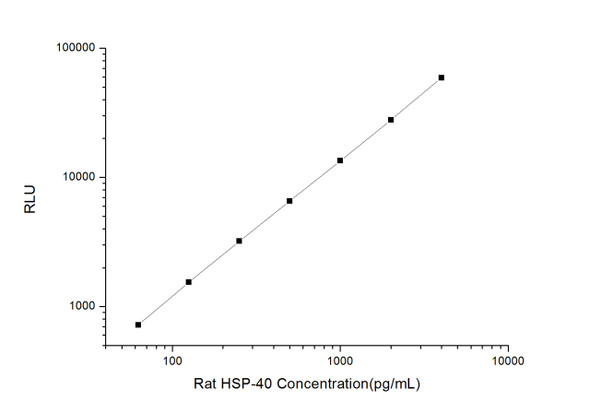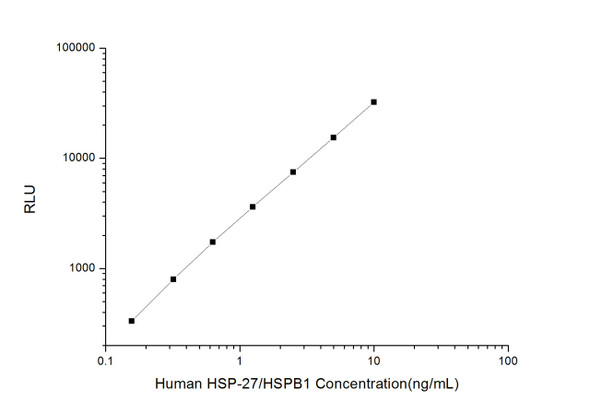Human Cell Biology ELISA Kits 5
Human HSP-40 (Heat Shock Protein 40) CLIA Kit (HUES01028)
- SKU:
- HUES01028
- Product Type:
- ELISA Kit
- ELISA Type:
- CLIA Kit
- Size:
- 96 Assays
- Sensitivity:
- 18.75pg/mL
- Range:
- 31.25-2000pg/mL
- ELISA Type:
- Sandwich
- Reactivity:
- Human
- Sample Type:
- Serum, plasma and other biological fluids
- Research Area:
- Cell Biology
Description
| Assay type: | Sandwich |
| Format: | 96T |
| Assay time: | 4.5h |
| Reactivity: | Human |
| Detection method: | Chemiluminescence |
| Detection range: | 31.25-2000 pg/mL |
| Sensitivity: | 18.75 pg/mL |
| Sample volume: | 100µL |
| Sample type: | Serum, plasma and other biological fluids |
| Repeatability: | CV < 15% |
| Specificity: | This kit recognizes Human HSP-40 in samples. No significant cross-reactivity or interference between Human HSP-40 and analogues was observed. |
This kit uses Sandwich-CLIA as the method. The micro CLIA plate provided in this kit has been pre-coated with an antibody specific to Human HSP-40. Standards or samples are added to the appropriate micro CLIA plate wells and combined with the specific antibody. Then a biotinylated detection antibody specific for Human HSP-40 and Avidin-Horseradish Peroxidase (HRP) conjugate are added to each micro plate well successively and incubated. Free components are washed away. The substrate solution is added to each well. Only those wells that contain Human HSP-40, biotinylated detection antibody and Avidin-HRP conjugate will appear fluorescence. The Relative light unit (RLU) value is measured spectrophotometrically by the Chemiluminescence immunoassay analyzer. The RLU value is positively associated with the concentration of Human HSP-40. The concentration of Human HSP-40 in the samples can be calculated by comparing the RLU of the samples to the standard curve.
| UniProt Protein Function: | DNAJB2: 2 isoforms of the human protein are produced by alternative splicing. |
| UniProt Protein Details: | Protein type:Chaperone Chromosomal Location of Human Ortholog: 2q35 Cellular Component: proteasome complex; inclusion body; nucleus; cytosol Molecular Function:protein binding; chaperone binding; unfolded protein binding; Hsp70 protein binding; polyubiquitin binding Biological Process: negative regulation of cell proliferation; ER-associated protein catabolic process; protein folding; positive regulation of protein ubiquitination; positive regulation of proteasomal ubiquitin-dependent protein catabolic process; protein refolding; negative regulation of cell growth; response to unfolded protein Disease: Spinal Muscular Atrophy, Distal, Autosomal Recessive, 5; Charcot-marie-tooth Disease, Axonal, Type 2t |
| NCBI Summary: | This gene is almost exclusively expressed in the brain, mainly in the neuronal layers. It encodes a protein that shows sequence similarity to bacterial DnaJ protein and the yeast homologs. In bacteria, this protein is implicated in protein folding and protein complex dissociation. Alternatively spliced transcript variants encoding different isoforms have been described for this gene. [provided by RefSeq, Jul 2011] |
| UniProt Code: | P25686 |
| NCBI GenInfo Identifier: | 158518384 |
| NCBI Gene ID: | 3300 |
| NCBI Accession: | P25686. 3 |
| UniProt Related Accession: | P25686 |
| Molecular Weight: | Predicted Molecular Mass: 34. 3kDaAccurate Molecular Mass: 37kDa |
| NCBI Full Name: | DnaJ homolog subfamily B member 2 |
| NCBI Synonym Full Names: | DnaJ heat shock protein family (Hsp40) member B2 |
| NCBI Official Symbol: | DNAJB2 |
| NCBI Official Synonym Symbols: | HSJ1; CMT2T; DSMA5; HSJ-1; HSPF3 |
| NCBI Protein Information: | dnaJ homolog subfamily B member 2 |
| UniProt Protein Name: | DnaJ homolog subfamily B member 2 |
| UniProt Synonym Protein Names: | DnaJ protein homolog 1; Heat shock 40 kDa protein 3; Heat shock protein J1; HSJ-1 |
| UniProt Gene Name: | DNAJB2 |
| UniProt Entry Name: | DNJB2_HUMAN |
As the RLU values of the standard curve may vary according to the conditions of the actual assay performance (e. g. operator, pipetting technique, washing technique or temperature effects), the operator should establish a standard curve for each test. Typical standard curve and data is provided below for reference only.
| Concentration (pg/mL) | RLU | Average | Corrected |
| 2000 | 55119 56323 | 55721 | 55693 |
| 1000 | 22109 25839 | 23974 | 23946 |
| 500 | 11408 10656 | 11032 | 11004 |
| 250 | 5177 5411 | 5294 | 5266 |
| 125 | 2797 2419 | 2608 | 2580 |
| 62.5 | 1402 1220 | 1311 | 1283 |
| 31.25 | 651 697 | 674 | 646 |
| 0 | 27 29 | 28 | -- |
Precision
Intra-assay Precision (Precision within an assay): 3 samples with low, mid range and high level Human HSP-40 were tested 20 times on one plate, respectively.
Inter-assay Precision (Precision between assays): 3 samples with low, mid range and high level Human HSP-40 were tested on 3 different plates, 20 replicates in each plate.
| Intra-assay Precision | Inter-assay Precision | |||||
| Sample | 1 | 2 | 3 | 1 | 2 | 3 |
| n | 20 | 20 | 20 | 20 | 20 | 20 |
| Mean (pg/mL) | 104.10 | 176.93 | 877.45 | 99.93 | 193.57 | 797.78 |
| Standard deviation | 9.47 | 14.90 | 83.80 | 12.28 | 23.17 | 48.51 |
| C V (%) | 9.10 | 8.42 | 9.55 | 12.29 | 11.97 | 6.08 |
Recovery
The recovery of Human HSP-40 spiked at three different levels in samples throughout the range of the assay was evaluated in various matrices.
| Sample Type | Range (%) | Average Recovery (%) |
| Serum (n=5) | 93-106 | 100 |
| EDTA plasma (n=5) | 85-99 | 92 |
| Cell culture media (n=5) | 92-104 | 98 |
Linearity
Samples were spiked with high concentrations of Human HSP-40 and diluted with Reference Standard & Sample Diluent to produce samples with values within the range of the assay.
| Serum (n=5) | EDTA plasma (n=5) | Cell culture media (n=5) | ||
| 1:2 | Range (%) | 99-117 | 93-106 | 92-106 |
| Average (%) | 108 | 98 | 97 | |
| 1:4 | Range (%) | 92-109 | 91-102 | 101-119 |
| Average (%) | 100 | 96 | 109 | |
| 1:8 | Range (%) | 97-111 | 103-118 | 94-105 |
| Average (%) | 103 | 109 | 100 | |
| 1:16 | Range (%) | 97-115 | 95-107 | 90-100 |
| Average (%) | 105 | 102 | 95 |
An unopened kit can be stored at 4°C for 1 month. If the kit is not used within 1 month, store the items separately according to the following conditions once the kit is received.
| Item | Specifications | Storage |
| Micro CLIA Plate(Dismountable) | 8 wells ×12 strips | -20°C, 6 months |
| Reference Standard | 2 vials | |
| Concentrated Biotinylated Detection Ab (100×) | 1 vial, 120 µL | |
| Concentrated HRP Conjugate (100×) | 1 vial, 120 µL | -20°C(shading light), 6 months |
| Reference Standard & Sample Diluent | 1 vial, 20 mL | 4°C, 6 months |
| Biotinylated Detection Ab Diluent | 1 vial, 14 mL | |
| HRP Conjugate Diluent | 1 vial, 14 mL | |
| Concentrated Wash Buffer (25×) | 1 vial, 30 mL | |
| Substrate Reagent A | 1 vial, 5 mL | 4°C (shading light) |
| Substrate Reagent B | 1 vial, 5 mL | 4°C (shading light) |
| Plate Sealer | 5 pieces | |
| Product Description | 1 copy | |
| Certificate of Analysis | 1 copy |
- Set standard, test sample and control (zero) wells on the pre-coated plate and record theirpositions. It is recommended to measure each standard and sample in duplicate. Note: addall solutions to the bottom of the plate wells while avoiding contact with the well walls. Ensuresolutions do not foam when adding to the wells.
- Aliquot 100 µL of standard solutions into the standard wells.
- Add 100 µL of Sample / Standard dilution buffer into the control (zero) well.
- Add 100 µL of properly diluted sample (serum, plasma, tissue homogenates and otherbiological fluids. ) into test sample wells.
- Cover the plate with the sealer provided in the kit and incubate for 90 min at 37 °C.
- Aspirate the liquid from each well, do not wash. Immediately add 100 µL of BiotinylatedDetection Ab working solution to each well. Cover the plate with a plate seal and gently mix. Incubate for 1 hour at 37 °C.
- Aspirate or decant the solution from the plate and add 350 µL of wash buffer to each welland incubate for 1-2 minutes at room temperature. Aspirate the solution from each well andclap the plate on absorbent filter paper to dry. Repeat this process 3 times. Note: a microplatewasher can be used in this step and other wash steps.
- Add 100 µL of HRP Conjugate working solution to each well. Cover with a plate seal andincubate for 30 min at 37 °C.
- Aspirate or decant the solution from each well. Repeat the wash process for five times asconducted in step 7.
- Add 100 µL of Substrate mixture solution to each well. Cover with a new plate seal andincubate for no more than 5 min at 37 °C. Protect the plate from light.
- Determine the RLU value of each well immediately.






